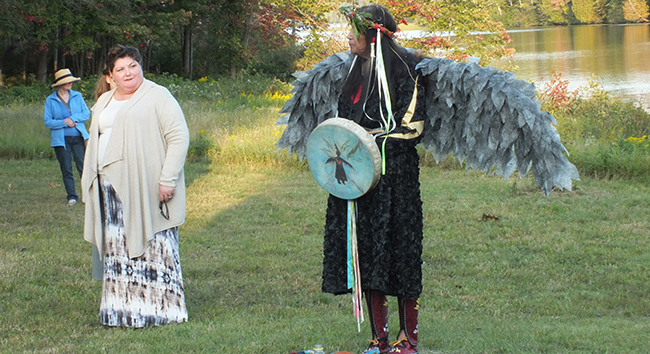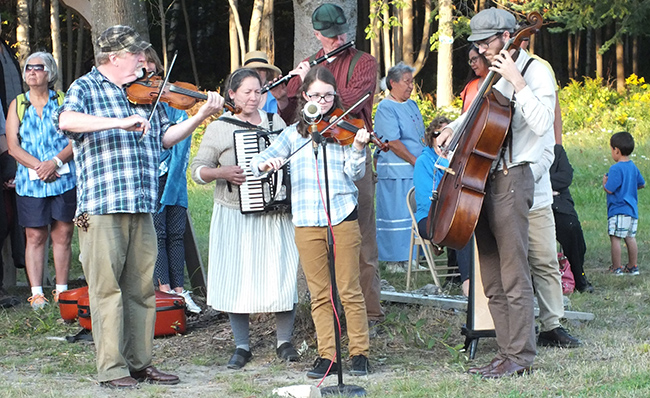‘The Rivers Speak’ draws over 600 people in Mississaugi First Nation


By Leslie Knibbs
MISSISSAUGA #8 – The Thinking Rock Community Arts group, located on the waterfront in Thessalon recently put on the performance of “The Rivers Speak” at the Misswezhaging (Mississaugi First Nation) Pow Wow grounds. The eight-day run over a two-week period finished up with a sold-out performance on September 16. All performances were held outside near the banks of the Mississaugi River. Unlike traditional theatre, this production was a giant step into the realm of experimental theatre.
“It’s not your traditional theatre,” said artistic director Robin Sutherland.
In traditional theatre, a play is performed on one stage with sequential scenes making up separate acts. the “Rivers Speak” took on the challenge of presenting a home-grown production of what would easily qualify as avant-garde theatre, where the cast moves to different stages in a natural environment and all the while performers are followed by the audience to the next act. This presentation was constantly evolving in different locations. The audience’s participation at times became interwoven with the cast’s performance. Becoming part of the production made the play that much more captivating for audience members.
Sutherland, creator of the group along with General Manager Miranda Bouchard acquired funding from the Ontario Arts Council, Ontario Trillium and Theatre Ontario to produce the play. Over a three-year-period, Sutherland worked with local residents from other communities to discover native history of the land and watercourses. The end result of three years working and visiting in the communities was the production of “The Rivers Speak”. The stories reenacted during the play came from both a settlers’ point of view as well as an Anishnaabe perspective.
One of the highlights of the performances was the musical accompaniment performed beautifully by a cellist, violin player, flutist, drummers, spoons, bagpiper and harpist as well as traditional Anishnaabe hand drums. Strangely enough, this unusual mix of instrumentation “filled the bill” either for mellow ambient background music for performances or, as a stand-alone main-stage-performance. All musicians were dressed in traditional costumes or regalia. One audience member suggested a full-on stage performance by the music group alone would have been worth the price of admission—they were an incredibly tight and diversely talented group. It’s hard to imagine step dancing Celtic music mixed with Anishnaabe drums – however, this combination worked superbly to the enjoyment of an appreciative audience who applauded loudly following each performance.
With a mix of professional and amateur actors from the area, the cast of over 50 brought a clear message of hope and resilience to audience members. Local Anishnaabe teachings speak of the River Serpent who inhabits the watercourses in the region. At the beginning of the production a group of actors portray the Serpent carving a trail for the river to flow. Thunderbird Woman, portrayed by Marly Day of Sault Ste. Marie stood not far from the river bank performing a song about the water and how it is everything to everyone. Her singing and acting transcended the craft of acting with a natural talent and genuineness, Day seemed to become the ‘Thunderbird Woman’ during her performance down by the river.
All of the stories told during the play were based on research acquired through oral history found in conversations with Max Chiblow, Marsha Lipsius, Isaac Murdoch, the late Earl Niganobe and Willie Pine. The play was dedicated “in loving memory of Earl Niganobe and Marian Wersch”. A special thank you to both at the end of the program was offered “for living such inspiring lives, and offering your stories to this project”.
According to Artistic Director Sutherland, “The approximate attendance for all shows was around 600 people. We will not be doing any more performances of this show, although there are discussions about recording a CD with music from the show. We will also be producing a short film about it in partnership with Village Electric out of Sault Ste. Marie.”
Two days after the final production and a likely much needed rest, creative director and writer, Sutherland mused, “I feel a great sense of pride and accomplishment in what we were able to achieve together as a team of artists and community participants, that we were able to use this play as an opportunity to bring Anishinaabe and non-Indigenous people from our area together to create something incredibly beautiful that is also reflective and respectful of all of our stories, histories, languages and spirituality, and that we were able to share that experience with so many people. I’m hopeful that the friendships and connections created through this process will change hearts and minds and lives for the long term. And I’m really looking forward to continuing to build on the relationships that have been built throughout this process.”
A member of the production staff said the final night performance exceeded all attendance expectations. Bus-loads of people came from Elliot Lake as well as Blind River to enjoy the production.


